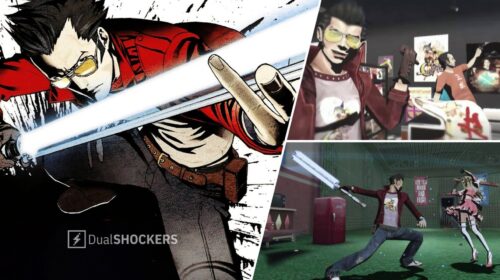The massive success of the Wii has seen many third-party developers rush to release games for the system as quickly as possible. Most of these titles were fairly simple mini-game collections that used the unique Wii features to a minimum, but a few managed to follow this formula successfully. Goichi Suda (better known as Suda51) was one of the most successful third-party developers for the Wii, who quit his job to work on the Fire Pro Wrestling series to open up his studio, Grasshopper Manufacture.
Grasshopper Manufacture was a small Japan-based studio, best known at the time for Michigan: Report from Hell, a poorly selling low-budget PS2 title, and Killer7, a GameCube title with some support from Nintendo that was well reviewed but failed to meet expectations. No More Heroes was released on Wii in 2007 and quickly became Suda’s biggest success as a director, and the game that put his studio on the map.
What made “No More Heroes” such a cult hit the endless sea of unforgettable Wii titles? For starters, its unique combat. Most people who first saw the Wii’s motion control and control mechanics immediately thought of a lightsaber. While the Wii has never seen the premium Star Wars game that used a lightsaber on the way, No More Heroes is likely the closest. The second is how charming the characters Suda has created. The main character Travis Touchdown is such a strange and lovable guy. Whether it was his love for ‘moe’ anime or his obsession with professional wrestling, it immediately affected the players.
The game centers around Travis trying to ascend to the United Assassin League in order to reach number one, winning a date with Sylvia, the woman who acts as his mentor through the UAA ratings. The game itself has several designed linear stages which lead to boss fights with the top 10 members of the UAA. Between these parts, Travis must get a certain amount of money in order to take the next opponent’s challenge. This can be done either by taking on special challenges like killing a priority target in a certain amount of time, or doing odd jobs like mowing the lawn and collecting coconuts. This balance between the mundane and the serious was emblematic of what made No More Heroes so likable.
By swinging your Wii remote in different ways, you can attack a low or high opponent, while mixing your swing power can unlock your opponents based on their positioning. The Katana has a battery that runs low depending on usage, and can be recharged by either picking up a battery, or charging manually by quickly moving the Wii remote in a suggestive motion.
One of the most memorable things about No More Heroes is its use of Wii mechanics. The oscillation mechanics involved in katana beam recharge is just one example of this. The tilt function of the Wii controller is largely related to mini games. The Wii speaker is also used for in-game phone conversations between Travis and Sylvia.
No More Heroes 1 and 2 have been ported to PS3. While these ports greatly improved the game’s performance, much of the charm has been lost to take advantage of the Wii’s pros. The satisfying final swing before ending an opponent wasn’t the same as when tied up with just a thumb stick thrust and not a fancy flip with your Wii controller. PS3 added PlayStation Move support later, in fairness.
After No More Heroes 2 was released in 2010, it was many years before another game in the series appeared. After Travis Strikes Again, a small game collection for Switch released in 2019, Nintendo signed a third game in the series released in 2021, with ports to other systems coming later this year.
No More Heroes is a game story that exceeded all expectations and became a hit. Goichi Suda’s subsequent work shows that there is still room for innovation in the video game industry, and that doing things a little differently can lead to successful IP ownership.
[ad_2]




